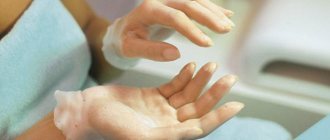What is bone reduction
Repositioning of the nasal bones is a fairly simple and common operation that is performed for fractures of the nasal bones. In this case, traumatic damage to the external and internal parts of the organ is eliminated. It involves realigning bone fragments immediately after a fracture. Its implementation is accompanied by severe pain, and the patient requires anesthesia. Most often it is performed under local anesthesia. Occasionally, for special indications, it is performed under anesthesia. After the anesthesia has taken effect, the doctor begins to realign the nose after the fracture. He strives to restore the nasal bones to their original position, which they occupied before the injury.
This manipulation should only be performed by an experienced surgeon, otherwise complications develop that negatively affect the patient’s appearance and interfere with normal nasal breathing. Incorrect reposition of the nasal bones after injury causes disturbances in the sense of smell.
What other problems does non-surgical nose reduction solve, besides size correction?
If the defects in the shape and size of the respiratory organ are not significant, you can resort to non-surgical reshaping. In this case, gentle techniques are used to achieve the desired result. Surgery is prescribed in extreme cases when conservative methods are ineffective or impractical.
Surgical nose reduction is performed according to medical indications. The procedure is called rhinoplasty. The intervention is carried out for medical or aesthetic reasons.
Before the procedure, a doctor’s consultation and diagnosis are required. Based on the results of the diagnostic examination, the doctor will individually select a surgical technique that will help get rid of the defects.
Contraindications for rhinoplasty:
- oncology;
- severe chronic pathologies of internal organs;
- allergy to anesthesia components;
- diseases of the cardiovascular system;
- diabetes mellitus, lupus erythematosus, HIV;
- acute infectious processes;
- mental disorders.
The operation is not prescribed for pregnant and breastfeeding patients. The procedure is also postponed if the woman begins menstruation on the day of the procedure.
Using special cosmetic threads, it will be possible to correct defects in the tip and wings of the organ. To reduce the size of the nose and give it the desired shape, the cosmetologist, using a thin cosmetic needle, makes micro-punctures in the skin, through which he then pulls threads. The fibers give problem areas the desired shape and size. Within two days after the procedure, the treated area will take on the desired appearance.
Changing the shape of the nose with hormonal injections is a popular non-surgical technique, the essence of which is that hormone-containing drugs injected into the soft tissues have a narrowly targeted effect, dissolving only individual fragments.
The main component of such injections is the steroid hormone glucocortisone. The dose and duration of therapy for each patient is determined by the doctor individually. It all depends on the complexity of the defect and the results the client expects. Hormonal injections should only be given under the supervision of a doctor. If you increase the dosage yourself or continue the course of injections, the risk of developing the following complications increases:
- tissue failures;
- formation of bone cavities.
To reduce the size of the nose, a special splint is used, which is attached to the olfactory organ so as to fix its position correctly. As soon as lasting results are achieved, the corrective device is removed. The first changes become noticeable only 5 – 6 months after regular use.
With the help of non-surgical correction, you can remove the hump, which spoils the appearance and is considered a cosmetic defect. However, the filler used for correction dissolves over time, so the procedure will have to be repeated.
For patients with an upturned or drooping tip, the defect can be corrected by injecting fillers into the problem areas. After the procedure, the tip will lower or rise, depending on what defect needed to be corrected.
Modern cosmetology offers many methods aimed at correcting appearance. Injection rhinoplasty (filling of the nasal area, contouring) has become very popular among patients of various age groups. Why is filling attractive? There are several reasons:
- No need for tissue dissection.
The patient does not need to be afraid of the operation, its consequences, or think about the likelihood of complications of anesthesia.
- Fast recovery.
After any type of surgical correction, rehabilitation is necessary (even short-term), and before the intervention begins, a long-term examination is required. Contour plastic surgery has contraindications, but they are much fewer than in the case of surgical plastic surgery.
- Possibility of additional correction.
In many cases, deficiencies identified in time can be corrected without a new course of contouring. For this purpose, special preparations are used that break down already injected fillers.
The effect of contouring must be maintained with repeated procedures.
Nose straightening without surgery lasts for a certain period of time - from several months to 2 years. This depends on the type of filler, technique of performing the procedure, and area of correction. To maintain a satisfactory result, filling must be repeated periodically.
Main reasons
The bones of the nose have a rather fragile structure and are often damaged by injury. Most often, this pathology occurs in boys under the age of twelve.
When injuries occur in the nasal area, the following structures break:
- external nasal bones;
- orbital walls;
- frontal processes;
- vomer;
- turbinates.
Trauma occurs when struck by a sharp or blunt object, but the mechanisms vary. The force and direction of the mechanical action play a decisive role. According to the mechanism of injury, injuries are:
- open with soft tissue damage;
- closed, the integrity of the skin, muscles and mucous membranes in the fracture zone is maintained;
- with displacement of bone fragments;
- impacted with deformation of the septum.
The bridge of the nose may fall inward if the fracture is combined with damage to the nasal septum. There are also unilateral and bilateral fractures.
There are the following options for injury to nasal structures:
- Lateral impact - in this case, the effect is on one of the side walls, which is directed transversely and does not coincide with its longitudinal plane. With this impact, a fracture occurs with the walls pressed into the organ cavity. Fragments of the septum move away in the direction of the impact force. Then the opposite wall is damaged. As a result, the patient develops a lateral fracture. (Figure 1.)
- When the force propagates from front to back, the impact falls on the front plane. A fracture of the nasal bones occurs in the area of bone sutures at the junction with the processes of the frontal bone and the bones of the upper jaw. Opener damage often occurs. At the site of damage, a saddle-shaped flattening of the back is formed. (Figure 2.)
The surgeon’s tactics, as well as the technique used to straighten the nose after a fracture, depend on the type of fracture.
The reasons why nasal bone fractures occur are quite varied.
causes of curvature and methods of correction
The specificity of non-surgical techniques is that they are used either to improve aesthetics or to restore respiratory function.
It is not possible to simultaneously solve aesthetic and functional problems without full-fledged surgical intervention. Injection plastic surgery. Aesthetic defects can be corrected using contour plastic surgery. Subcutaneous injections of dermal fillers can mask the deficiency by increasing the integumentary tissue on the side of the nose where there is a relative lack of volume.
Plastic surgery with hyaluronic acid has a number of advantages. It does not require long preparation and has a minimum of contraindications. It is carried out in an outpatient setting at a beauty salon and takes no more than an hour. You can return to your usual social and work activities on the day of correction. Recovery is fast and does not require compliance with many rules: it is enough to avoid exposure to high temperatures, do not play sports, and do not sunbathe in a solarium.
The disadvantage of the technique is its very limited capabilities. Only a minimal degree of asymmetry can be corrected; in other cases, the patient will not receive the desired effect. As for functional problems (nasal congestion, frequent colds, vasomotor or allergic rhinitis) caused by a deviated nasal septum, the injection method cannot solve them. It should also be mentioned that dermal fillers provide a temporary effect; after 12 months, repeated correction is required.
Laser septochondrocorrection. There is also a method of non-surgical septum plastic surgery, which is called laser septochondrocorrection. The principle of the technique is based on heating the anterior part of the septum with a laser beam. Thermal exposure leads to softening of the cartilage. When the cartilage becomes plastic, the surgeon changes its shape using simple manual manipulation.
At first glance, this method looks very promising, but in reality, thermoplastic partitions are not without significant drawbacks. Firstly, thermal septoplasty allows you to correct only the curvature of the anterior, cartilaginous, part of the nasal septum. When applied to an external defect, it is effective only for asymmetry in the nostril area. For significant deformations caused by curvature of bone structures, the method is not used.
Secondly, laser septochondrocorrection has been used in otorhinolaryngology for only a few years. Doctors do not yet have data on the long-term results of thermal plastic surgery, just as there is no complete information about the safety of such effects in the long term. It remains to be said that the procedure is very expensive. The high price, given the limited capabilities of the technology, cannot be called justified.
pronose.ru
Indications for nasal bone repositioning
Before repositioning the bones, the doctor determines whether the patient has symptoms indicating this damage. Before surgery for a nasal fracture, signs indicating the presence and nature of the fracture are assessed.
Indications for repositioning of the nasal bones are:
- retraction of the back;
- deviation of the nasal septum to the side;
- deformation of the nasal walls with partial collapse of the back;
- damage to the bones that form the paranasal sinuses;
- constant recurrent bleeding;
- the appearance of a hump in the bridge of the nose, if it was not there before.
Open and closed injuries of the nasal bones, fractures with displacement of fragments and damage to the septum are subject to reduction.
Irregular nose
The root causes of the irregular shape of the olfactory organ:
- congenital;
- acquired.
In the first case, the deformation occurs during the period of intrauterine development. Acquired deformities are most often a consequence of injuries, chronic diseases occurring in the nasopharynx, and infectious diseases.
Characteristic features of an irregularly shaped nose:
- asymmetry;
- unevenness, depressions, failures;
- tip defect;
- a hump on the back or a flat back;
- sagging, sagging skin;
- deviated nasal septum.
When and by whom is it carried out?
Reposition is carried out by a traumatologist or surgeon in the trauma department of medical institutions. To carry out reposition of damage to the nasal bones, the patient is hospitalized in the following cases:
- severe deformation of the nasal walls;
- heavy bleeding;
- combined injury with damage to other facial bones.
Reduction of simple nasal fractures is performed on an outpatient basis in emergency rooms or clinics.
It is important for the patient to seek medical help as early as possible. When there are fractures of the nasal structures, the fractures heal quickly and callus quickly forms between the damaged areas. After three or four days it is already quite difficult to set the fragments after a fracture. Ten days after the injury, this can only be done using special surgical instruments.
Timing and methods of reposition
It is advisable to perform the repositioning operation in the first hours after the fracture. The optimal period for repositioning a fracture of the nasal bones is considered to be from five hours after the incident to seven days. For closed displaced fractures, closed reduction of the nasal bones is performed.
The following techniques are used:
- finger;
- instrumental;
- finger-instrumental.
In the case of an open fracture, the wound is treated with antiseptics. Then all small bone fragments are removed from the wound. Only after this the nasal bones are repositioned.
How is it carried out?
Patients are often interested in whether it hurts to straighten their nose. This procedure is practically painless, as one type of anesthesia is always used. Correction of a broken nose is performed under local or general anesthesia. Before the fragments are repositioned under general anesthesia, the patient is injected with Propofol or Ketamine. For local anesthesia, the injury area is injected with Lidocaine or Novocaine. You can also use these drugs in the form of sprays by spraying them onto the nasal mucosa. Then the back is aligned in various ways. In case of a fracture, the Doctor compares the bone fragments with each other. After the manipulation, the patient is observed by an ENT doctor for up to three weeks.
Types of reduction
There are several ways to restore the shape of the nasal bones. Only the attending physician decides which one to choose. His decision is based on the identified type of damage to the nasal bones and the degree of their impairment, as well as the presence of combined trauma to the bone structures and soft tissues of the face.
Closed
How to straighten your nose using closed reduction. A closed fracture is not considered a complex injury, so the operation is always performed under local anesthesia. For simple fractures without displacement, reduction is carried out only with the help of hands, without the use of special tools. In case of a displaced fracture, for surgery with reposition of fragments, a special surgical instrument is used - an elevator. After surgery, tight gauze swabs are inserted into each nostril of the patient. They are pre-impregnated with antiseptic solutions. They stay in the nasal passages for about four days. A plaster cast is applied on top of the injury area. It holds the bones in the required position for proper fusion of fragments and ensures accelerated fusion.
Open
How to set a broken nose with open reduction. During this operation, the surgeon not only performs repositioning of bone fragments. It treats and restores the integrity of injured soft tissues. The doctor begins manipulations by treating the wound surface with hydrogen peroxide. Then anesthesia is performed, followed by surgery. The doctor removes targeted fragments if they are not associated with soft tissues and bone structures. Then the doctor repositions the fragments. After this, stitches are placed on the wound. If the wound is heavily contaminated, pus is visible, or there is crushing of tissue areas, then the wound is not sutured. This makes it easier to treat until it is completely sanitized. After the operation, the patient is required to be prescribed a course of antibiotic therapy. Antiseptics and wound-healing drugs are applied locally to the wound area.
Finger
This technique is used to reposition lateral displacements of fragments. The surgeon only needs one correct press to return the bone fragments to their original place. No tools are used for this manipulation.
Instrumental
When performing instrumental reposition of a fractured nasal bone, a special tool – a Volkov elevator – must be used. First, the doctor determines the required depth of insertion of the instrument from the outside of the nose, applying it from the outside. He then administers anesthesia. After this, the doctor inserts the instrument into the nostril from the damaged side. He lifts the damaged fragments, they fall into place. In case of bilateral damage, the same is done on the other side. The doctor strives to restore the original shape.
Finger-instrumental
This technique is used to correct a broken septum with a pronounced retraction of the back inward, combined with a lateral displacement. In this case, instead of elevators, cotton-gauze turundas and a special dilator for the nasal passages are used. These instruments widen the nasal passages, and the doctor uses his hands to return the bones to their place. Afterwards, the nasal passages are tightly packed with gauze turundas, pre-lubricated with Vaseline.
A nose with an old fracture can be straightened using rhinoplasty. Only experienced plastic surgeons straighten the nasal bones in this way.
Reposition of nasal bones in a child
In a child, tissue regeneration occurs faster. The bones heal within four weeks. In children, due to good blood supply to the tissues, the pharyngeal mucosa quickly swells, which interferes with normal breathing. In case of injury, you should immediately go to the emergency room. For mild fractures, only anterior tamponade is often performed. The doctor inserts special tampons into the baby's nasal passages. They lift and return displaced bone fragments to their place. For a fracture with significant displacement to the side in children, only the finger technique is used. The surgeon, without using instruments, uses his hands to return the fragments to their original place. An elevator for repositioning a child is used only for fractures with a large number of fragments and displacement of the back into the nasal cavity. With its help, bone fragments are lifted and returned to their original place. Fixing a broken nose in children is a rather painful procedure. It is often performed under general anesthesia.
How to straighten your nose yourself
You can straighten your nose without a doctor only in a completely hopeless situation. At the same time, it is necessary to understand that other consequences of TBI and the like may make themselves felt in the near future.
You can try to eliminate only a small lateral displacement. To do this, you need to cover your nose with ice, after 5-7 minutes, grab the back of your nose with your thumb and forefinger in the place where the displacement is visible, pull first down and then in the direction opposite to the curvature. If the procedure is successful, you will feel your nose move back into place. Try to secure it in this position and use antiseptics.
Treatment and rehabilitation after reposition
Fixing a broken nose is often not enough; recovery requires treatment of the patient and subsequent rehabilitation. The final healing of a broken nose occurs up to three months after the injury. In case of open fractures and serious damage to soft tissues, the doctor prescribes antibacterial drugs to the patient, taking into account data from testing the sensitivity of the bacterial flora to antibiotics.
The patient undergoes the following procedures:
- The patient, after the broken nose has been fixed, undergoes physical therapy to speed up recovery. Infrared irradiation is often used. It increases blood supply to the area of damaged bones, promoting rapid tissue restoration. The course lasts no more than fifteen procedures, with a total duration of twenty minutes.
- Electrophoresis is widely used to deliver nutrients and microelements to damaged tissues in the deep layers.
- UHF is prescribed to the patient to relieve swelling and inflammation of the soft tissues of the nose.
After the operation, the patient is prohibited from sleeping on his side and stomach to prevent additional trauma to the reduced nose. It is forbidden to wear glasses, they put pressure on the back. It is not recommended to engage in active sports during the entire recovery period. Visiting the sauna and bathhouse is not recommended, as this increases blood supply to the facial area and increases swelling.
Possible complications
If fractures of the nasal bones are treated incorrectly or the patient seeks medical help late, complications arise.
These include the following adverse effects:
- A deviated nasal septum is common. It leads to impaired nasal breathing and the formation of chronic rhinitis. A focus of chronic infection appears in the nasal cavity and nasopharynx. It can provoke the occurrence of a purulent process in the body at any time.
- Visible deformation of the nose occurs with severely displaced injuries. It always accompanies a deviated nasal septum and is complicated by the development of chronic inflammation of the nasal mucosa.
- Subcutaneous hematomas and bleeding occur both immediately after injury and in the long-term period. It stops during internal and external tamponade.
- Infection occurs when bacteria enters the wound. The inflammatory process increases. As a result, it develops not only in soft tissues, but the infection penetrates into the nasal sinuses. Sinusitis, frontal sinusitis and ethmoiditis develop.
- After injuries to the nose, scar changes and synechiae of the nasal cavity sometimes form. They disrupt nasal breathing and reduce the sense of smell.
When a fracture of the nasal bones is combined with damage to the skull, the patient develops severe neurological symptoms. This causes disability.
How to straighten and correct a crooked nose without surgery - ENT Plus
The reasons for changes in the shape of the septum are divided into physiological, traumatic and compensatory. Physiological curvatures are associated with uneven growth of cartilage and bones.
Traumatic displacements result from bruises received in fights, while playing sports, etc. Compensatory deformations are associated with enlargement of the turbinates, the entry of foreign objects into the nasal cavity and the appearance of polyps.
As a result, pressure occurs on the plate and it moves.
The nasal septum performs many important functions: it humidifies the inhaled air, warms it, and ensures balance in the distribution of air in the right and left nostril. Of course, we must not forget about the sense of smell. The functions of warming and moisturizing come to naught with a deviated septum. Most often, this disease affects adult men, less often – women, and very rarely – small children.
The causes of curvature can be not only injuries, but also improper growth of the skull bones, polyps and tumors in the nose, an overdeveloped nasal concha, which presses and bends the septum.
Of course, a person himself is unlikely to be able to understand whether he has a deviated nasal septum, but there are some symptoms that indicate this:
- irregular nose shape,
- constant runny nose,
- headache,
- snoring and sleep apnea (short-term cessation of breathing during sleep),
- constant colds,
- cough and sore throat,
- ear pain.
A deviated nasal septum is present to a greater or lesser extent in 90% of people. However, mostly it goes unnoticed and does not cause any inconvenience.
Reasons for the formation of deviated nasal septum:
- Physiological reasons. The uneven growth of the brain and facial parts of the skull, as well as different parts of the septum, leads to the fact that the septum bends in one direction or another, some parts of it thicken, and bone growths appear - spines and ridges. Such defects form most intensively in adolescence (12-16 years), but congenital deformities that arise in the prenatal period also occur.
- Injuries. This is the most common cause of septal deformation. Most often these are nasal fractures. For obvious reasons, they are more common in adolescents and men (fights, sports injuries). But sometimes even a minor injury to the nose without a fracture, received in childhood and passing almost unnoticed, can subsequently cause a significant curvature of the septum. The reason is the displacement of the growth zones, which are located at the border of the cartilage and bones of the septum. In children, septal displacement can occur during childbirth, especially with facial presentation.
- Compensatory reasons. It happens that the septum shifts under the influence of some factor that puts pressure on it. This could be an overgrown nasal concha, a polyp, or a tumor.
At first glance, man is a symmetrical creature. However, ideal symmetry does not exist in living organisms; too many factors influence their development. Same with the nasal septum. 90% of people have a deformity of the nasal plate to one degree or another.
But most do not even suspect that they have such a pathology. Basically, people with a crooked nasal septum either do not have any complaints, or do not in any way relate their complaints to this defect.
The severity of symptoms is not directly dependent on the degree of curvature. It happens that a person with a severe curvature does not feel any discomfort at all. Conversely, even a slight deviation of the septum can cause complications.
There are no specific (pathognomonic) symptoms characteristic only of a deviated nasal septum.
- Nasal congestion. This is perhaps the most common complaint of patients with a deviated nasal septum. A person cannot breathe normally through his nose for a long time; he continually drips vasoconstrictor drops into his nose, which only aggravates the situation due to the development of vasomotor rhinitis.
- Frequent acute sinusitis or the presence of a chronic inflammatory process in one or more sinuses.
- Acute or chronic otitis media.
- Dacryocystitis. Violation of the outflow of tear fluid through the nose leads to disruption of the natural cleansing of the eye and inflammation of the lacrimal sac.
- Snore.
- Impaired sense of smell. In the area of the upper nasal passage there is the olfactory zone. If the curvature is localized in the upper part of the septum, the patient may not feel odors.
- Frequent headaches.
- Nosebleeds.
- Hearing loss.
Pain in the nasal septum is not typical for uncomplicated curvature, unless it is a recent injury. So, if the nasal septum hurts, you need to look for other causes - sinusitis, boil, neuralgia of the nasociliary nerve.
It is always quite difficult, even for a doctor, to associate these symptoms with a deviated nasal septum, especially in patients with concomitant pathology (chronic vasomotor rhinitis, allergic rhinitis), hypertrophy of the nasal turbinates. Surgery to correct a deviated nasal septum is usually offered after unsuccessful conservative treatment for these diseases.
Causes of deformation and displacement of the nasal septum
Before prescribing treatment, the doctor, through examination and a series of procedures (radiography, tomography, rhinoscopy), determines the degree of deformation. If the curvature is significant, the only option is surgical correction, since only this method can restore the correct anatomy of the nose.
For most people, a crooked septum does not cause any serious inconvenience. They don’t have to straighten it through surgery, but use more gentle methods: laser correction, medications, clips, massage, breathing techniques.
The main alternative to classical surgery is laser correction. This is a minimally invasive procedure that takes place without compromising the integrity of the mucous membrane. The cartilage is heated by a laser and becomes flexible enough to be shaped into the correct shape.
Despite its advantages, the procedure also has significant disadvantages. This is a relatively new technique, so there is no research into how it affects the patient in the distant future. It is advisable to use it if the deformation has affected the cartilaginous part; it is impossible to align the bones in this way. This procedure is also expensive.
Deformation does not always affect air circulation. When prescribing treatment, the degree of breathing difficulty is taken into account, and not the curvature of cartilage and bones. It is possible to normalize the functioning of the nose not only through surgery, but also through medications. The patient is prescribed decongestant tablets or drops, antihistamines if allergies are present, and steroid sprays to relieve inflammation.
Medicines only affect the mucous membrane, so congestion is eliminated in this way, but correction of the nasal septum is impossible without surgery or chondrocorrection. The method also has disadvantages. With frequent instillation of vasoconstrictor drugs, regular vasospasm occurs. The body turns on a compensatory mechanism, tissues begin to grow and thicken.
It is possible to normalize the functioning of the nose without resorting to surgery or high-priced medications. Eliminate swelling of the mucous membrane with drops of beet or honey infusions, breathing will become easier after special exercises and massage.
Deformations of the nasal septum are divided into several types:
- A shift to one side or the other from the median position. The arching of the nasal plate can be S-shaped or C-shaped, in different planes.
- Spines are pointed projections of the bony part of the septum.
- Ridges are elongated bone growths.
- A combination of two or three types of deformities. This type is the most common.
Also, curvatures can be one- or two-sided.
Consequences of a deviated nasal septum
The nasal passages play a huge role in protecting the respiratory tract: warming, humidifying and disinfecting the inhaled air occurs here.
A slight deviation of the septum in one direction or the other does not cause any unpleasant health consequences. But if the curvature is significant, significant health problems may arise.
Thus, the curvature of the septum affects the direction of air passing through the nasal passages, causes microtrauma and inflammation of the mucous membrane, reducing barrier protection. As a result, conditions are created for the proliferation of microbes in the nasal passages and paranasal sinuses. All this leads to the development of rhinitis, sinusitis, and sinusitis.
The inflamed nasal mucosa allows the penetration of various allergens, and this can lead to the gradual development or exacerbation of bronchial asthma or other allergic diseases.
A deviated septum prevents sufficient air from being inhaled. As a result, the brain suffers due to lack of oxygen.
If septal deformation is observed for a long time, chronic brain hypoxia occurs. This in turn leads to headaches, sleep disturbances, hearing problems, and a slow reaction to events.
This is very dangerous, especially in childhood and can lead to mental retardation.
The immune system also suffers; such people are more likely to suffer from respiratory infections, and they may experience intestinal disorders.
All these negative aspects significantly worsen the quality of life and even, as scientists have noted, lead to a reduction in life by 5–6 years.
Forecast
If the patient approaches early and the broken bones are successfully repositioned, the prognosis is favorable. With late presentation of the patient and complex fractures with displacement, deformation of the bridge of the nose occurs with the formation of a gross cosmetic defect. It can be corrected with plastic surgery.
A nasal fracture is often considered a minor injury and is not sought medical attention. However, if help is not provided in time, severe deformations are possible - this is not only a cosmetic defect, but also interferes with the patient’s breathing.










